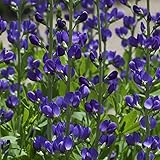All Categories







Outsidepride 100 Seeds Perennial Baptisia Blue False Indigo Flower Seeds for Planting
Share Tweet








Outsidepride 100 Seeds Perennial Baptisia Blue Features
-
Wild Indigo isgreat to have in any flower garden as it can grow in a variety of soil conditions. Perennial false indigo is hardy, virtually pest and maintenance free and provides interest in the garden all year long. False indigo has deep blue flowers which appear in late spring to early summer on stems of blue-green leaves.
-
Grows as a perennial in USDA zones 3 - 9 reaching a height of 40 inches.
-
The dark, shiny seed pods that follow the flowers last through fall and winter providing interesting color and texture to the winter flower garden. The best place to plant false indigo seeds, or blue false indigo as it is sometimes called, is in any dry, average or medium wet well-drained soil.
-
Planting in a full sun location for best blooming, but it will tolerate partial shade. Follow a regular watering schedule during the first growing season to establish a deep, extensive root system for the wild indigo. Feed with a general purpose fertilizer before new growth begins in spring. Prune old flower heads to encourage more blue indigo blossoms.
-
Sow 2 - 3 seeds per plant to being growing your false indigo plants today.
About Outsidepride 100 Seeds Perennial Baptisia Blue
Blue False Indigo (Baptisia Australis) – Wild Indigo isgreat to have in any flower garden as it can grow in a variety of soil conditions. Perennial false indigo is hardy, virtually pest and maintenance free and provides interest in the garden all year long. False indigo has deep blue flowers which appear in late spring to early summer on stems of blue-green leaves. The dark, shiny seed pods that follow the flowers last through fall and winter providing interesting color and texture to the winter flower garden. The best place to plant false indigo seeds, or blue false indigo as it is sometimes called, is in any dry, average or medium wet well-drained soil. Planting in a full sun location for best blooming, but it will tolerate partial shade. Follow a regular watering schedule during the first growing season to establish a deep, extensive root system for the wild indigo. Feed with a general purpose fertilizer before new growth begins in spring. Prune old flower heads to encourage more blue indigo blossoms.






















